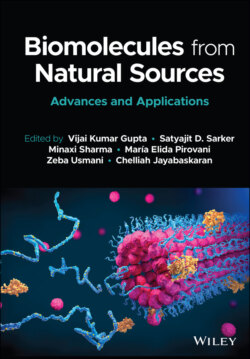Читать книгу Biomolecules from Natural Sources - Группа авторов - Страница 27
1.6 Downstream Process
ОглавлениеThe downstream process is probably the major problem to overcome in bioprocesses, as normally the purification of the target biological compound can account for over half of the manufacturing cost in many biotechnology processes (Desai and Banat 1997). In fact, even if production is optimized related to media and culture conditions, the manufacturing process is incomplete without an efficient and economical strategy for the recovery of the bioproducts. For many biotechnological products, the downstream processing costs account for 60% of the total production costs.
In the recovery of biosurfactants several conventional methods have been used over time, like acid precipitation, solvent extraction, crystallization, ammonium sulfate precipitation and centrifugation (Desai and Banat 1997). One of the main problems in these recovery processes is the toxicity of the solvents (e.g. acetone, methanol, chloroform) in nature and which are harmful to the environment. In recent years an alternative to those solvents was the use of methyl tertiary-butyl ether (MTBE), a cheap and less toxic solvent, mainly used in the recovery of biosurfactants produced by Rhodococcus (Kuyukina et al. 2001; Philp et al. 2002).
In the case-study of the trehalose lipid downstream process, although a variety of methods are available, the most commonly used is solvent extraction. In fact, extraction is one of the most used to obtain a crude extract free from the aqueous culture medium. One of the main problems is the number of impurities, often co-extracted during extraction along with several structural types of the target biosurfactant. Afterwards, they need to be evaluated by separating and removing the impurities. There are different mixtures of solvent systems that can be used, the three most frequently used are chloroform-methanol, methyl tert-butyl ether (MTBE), or a mixture of ethyl acetate-methanol (Franzetti et al. 2010). When the goal is the production of trehalose lipids to be applied in the biomedical field, some of the solvent/extraction systems may represent a problem, due to their toxicity.
Other interesting methods have been reported, such as foam fractionation (Davis et al. 2001), ultrafiltration (Sen and Swaminathan 2005), adsorption–desorption on polystyrene resins and ion exchange chromatography and adsorption–desorption on woodbased activated carbon (Dubey et al. 2005). These methods are based on the surface activity of trehalose lipids or their ability to form micelles and/or vesicles and are particularly useful for large-scale continuous recovery of extracellular biosurfactants, with high purity from culture broth. In particular in the pharmaceutical industry, but also in the food and cosmetic industries, individually purified trehalose lipids are required. In these applications the trehalose lipids can be obtained performing multistep recovery by further purification steps. Silica gel column chromatography is a relatively inexpensive method that can be combined with other methods to purify trehalose lipids. Using this technique milligram to kilogram quantities can be obtained free from impurities and can also be used to separate structural types of trehalose lipids for further analysis.
